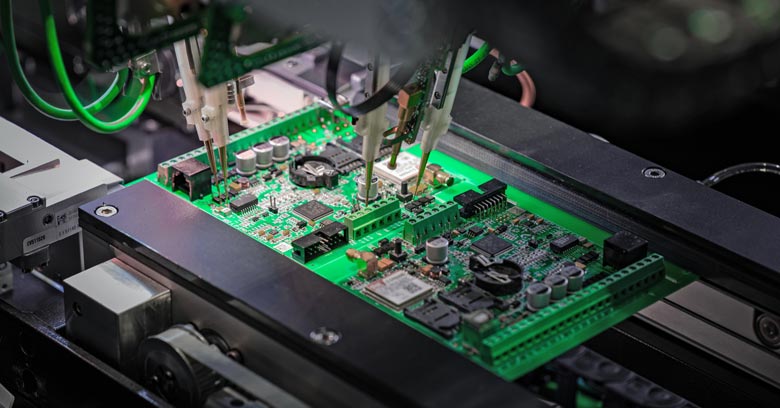
Electronics production contributes to a significant part of Vietnam’s manufacturing output and exports. With multinationals such as Samsung, Foxconn, and Intel present, Vietnam has become a top electronics manufacturing nation in the past decade in terms of export value.
The country also benefits from the current trade tensions globally, involving the US, China, and Russia. During such tensions, large corporations tend to look for markets with more stability, low labor costs, and attractive tax incentives to relocate factories.
Vietnam’s Electronics Manufacturing Industry
Vietnam is one of the top exporters of electronics, having an export value equal to 1.8% of the total export value of electronics globally. The country climbed from the 47th position in global ranking in 2001 to the 10th position in 2020.
The development of the electronics industry is a result of both domestic reasons and external events. The most important are the low labor costs, tax incentive policies, favorable global trade conditions, and many free trade agreements (FTAs).
Samsung and Intel could be considered as some examples of the first generation of foreign investors that set the foundation for the electronics manufacturing industry. Until now, Vietnam is the favorite manufacturing hub for many other global giants, including LG, Foxconn, and Canon.
Although the market is dominated by the top global manufacturers, domestic companies have been improving their importance in the electronics manufacturing supply chain. The number of domestic Tier-1 suppliers for Samsung has been rising.
Moreover, Vietnam has seen more domestic electronic brands popping up in the past years, such as BPhone (smartphone by BKAV), Viettel (Telecommunication Corporation under the ownership of Ministry of Defence), and Vsmart (smartphone by Vingroup. Production terminated in 2021).
The localization rate is still low (5% to 10%) as most of the products from these domestic brands are imported or assembled with imported components. However, this opens a new era for the electronic products of Vietnamese brands.
What electronics products are manufactured in Vietnam?
Consumer goods account for most of the electronics production in Vietnam. The products are mostly produced in the Northern provinces of Vietnam (Bac Ninh, Bac Giang, Hai Phong), as they can utilize the supply of components in the close neighboring areas.
Meanwhile, Intel, with its product portfolio of processors and electronic chips, has been investing significantly in the South of Vietnam.
Mobile phones and components (MPC)
Vietnam has become a global hub to produce mobile phones and related components. Samsung, for example, produces 60% of all its mobiles here.
Having said that, Vietnam is known for being strong in midstream activities. Upstream activities, which involve the designing and production of sub-components, are mostly done overseas.
The same goes for downstream activities, involving sales and distribution, which is also primarily done outside of the country. Local companies focus much on the assembly of finished products and sub-assemblies for export.
As a result, Vietnam has become a major manufacturing and assembling destination for most world-class mobile phone manufacturers. Samsung and Google have already set up shop in the country, while Xiaomi announced plans to establish a factory in Hai Phong.
Regardless of the heavy dependence on foreign-invested enterprises, Vietnamese domestic companies have been improving their competitiveness. This is evidenced by the growing involvement of Vietnamese companies in the supply chain of big manufacturers.
The number of domestic Tier-1 suppliers for Samsung has grown rapidly over the past few years and will continue to rise.
Computers, laptops, and components (CLC)
CLC products are currently in the top five product categories that have a total export value of more than 5 billion USD.
Spurred by growth from its developing domestic market, most of the CLC are exported to foreign markets. Major importers include China, the US, ASEAN, Japan, and Korea. Interestingly, we also see growing exports of electronic products to many Eastern European countries in Europe, including Hungary, Poland, the Czech Republic, and Slovakia.
Due to the increasing demand for CLC products during the pandemic, the industry thrived throughout 2020 and 2021. Nikkei Asia even estimates that half of the world’s laptops will be manufactured in Southeast Asia and where Vietnam is the leader in terms of manufacturing volume.
Like smartphones, most of the CLC manufacturers/assemblers choose the North of Vietnam for manufacturing activities. It’s estimated that two-thirds of the foreign electronic manufacturers have their factories in the North, while the rest is shared between the Central and Southern regions.
Benefits of Sourcing Electronics in Vietnam
As a result of the above, Vietnam has become one of the most preferred destinations to set up electronics manufacturing in Asia. Below you can find notable reasons why foreign companies chose to relocate production here.
Besides, Vietnam also benefits from several free-trade agreements (FTA), which certainly ease the procurement process, especially for international trade. This is something we will review later in this article.
Low labor costs
Labor costs are considerably low and around one-third of China’s. Worth mentioning is also that wages increase at a slower pace in Vietnam. This is also lower than other manufacturing hubs in the region like Malaysia or the Philippines.
Thanks to the low labor costs and trade agreements, many global manufacturers have moved part of their manufacturing facilities to Vietnam recently. One example is TCL who has established a new 73,000-square-meter factory in Vietnam, due to escalating tensions between the US and China.
Electronics manufacturing capabilities
As mentioned, Vietnam is primarily strong in midstream activities. Upstream activities that involve design-making and the production of components are mostly carried out overseas. Thus, manufacturing activities focus more on assembling, including products like smartphones, TVs, and laptops.
First-generation global manufacturers, like TCL and Hitachi, have established production in the country since long, building up superior supply chains. Together with other multinationals, they now account for much of the production of consumer electronics, including TVs, refrigerators, and speakers.
Other electronic products are chips, with the typical example of Intel, which assembles and tests the products in Vietnam. Thanks to continuous investments, the company saw improvements to enhance its capability of manufacturing Intel’s 5G product line, core processors integrated with its hybrid technology, and 10th Gen Core chips.
Vietnam is a highly specialized market, primarily focusing on consumer products. It needs to become less reliant on imports and bring more value-added services to attract more global investors.
Free trade agreements
Since it joined the World Trade Organization (WTO) in 2007, Vietnam has been actively negotiating and joining several FTAs. 13 out of 15 currently active FTAs has come into effect since 2007.
Vietnam enjoys many free trade agreements, most recently with the EU and the United Kingdom. It also has a bilateral trade agreement with the US, meaning that WTO’s standard tariffs are used.
The FTAs allow a better tariff system to be applied to trading activities between participating countries. This has not only created a competitive advantage in terms of pricing but also eased the trading process among the participants.
To read more about the free trade agreements, you can read our separate article about sourcing and manufacturing in Vietnam.
Support from the Government
The Government has introduced different tax incentives, allowing companies to choose a model that best suits their businesses.
Corporate Income Tax (CIT) breaks are allowed for some companies in high-tech industries or located in high-tech industrial zones. Other tax incentive programs for up to 15 years include either tax exemption, tax rate reduction, or both.
R&D projects can also have part of their annual profit as the tax reduction before the actual tax is levied.
Moreover, electronics is one of the key agendas in the industrial development plan of the Vietnamese Government, with a vision from 2025 to 2035.
Semiconductor Manufacturing in Vietnam
Vietnam’s semiconductor industry started to form more than 30 years ago, due to its importance to other tech-related industries. However, as of now, the country has no active and official semiconductor manufacturing factories.
The Electronic Circuit Industry is one of the nine key industries that the Government has focused on developing since the early stages.
The State-owned factory Z181, owned by the Ministry of Defence, produced semiconductor electronic materials and components such as transistors, diodes, thyristors, and semiconductor sensors.
Some of those were exported to Czechoslovakia, the Soviet Union, and Poland during the period 1979 to 1989.
Although receiving significant support from the government since decades back, the semiconductor industry is far behind many global competitors. Experts pointed out three challenges of the industry:
- Significant capital requirements
- Limited supplies of relevant machinery
- A stable market dominated by reputable corporations, which leaves less room for new and small-scale businesses
Summary
Vietnam is one of the biggest exporters of electronic products globally, being the home to multinationals like Samsung, Intel, Foxconn, and LG. Many of these companies have been present for decades, managing to build up strong supply chains, thanks to early long-term investments.
The Vietnamese government has introduced several attractive legacies to attract more foreign companies. Examples include tax incentives, new hi-tech zones, and industrial parks. Low labor costs and several FTA also contribute significantly to the cost-saving to create competitiveness among large companies.
Worth highlighting is also Vietnam’s large labor pool that is involved in the production of most consumer electronic products, and related components.
However, keep in mind that electronics manufacturing is concentrated with a focus on a few product types, primarily: Phones, PCs, TVs, cameras, and related components. And this is primarily for mid-stream activities.
Mainland China, Japan, Korea, Malaysia, Taiwan, and India are some alternative markets to watch.
Read more about our market entry services or other consulting capabilities.
The insights provided in this article are for general informational purposes only and do not constitute financial advice. We do not warrant the reliability, suitability, or correctness of the content. Readers are advised to conduct independent research and consult with a qualified financial advisor before making any investment decisions. Investing in financial markets carries risks, including the risk of loss of principal. Past performance does not guarantee future results.
The views expressed herein are those of the author(s) and do not necessarily reflect the company's official policy. We disclaim any liability for any loss or damage arising from the use of or reliance on this article or its content. ARC Group relies on reliable sources, data, and individuals for its analysis, but accuracy cannot be guaranteed. Forward-looking information is based on subjective judgments about the future and should be used cautiously. We cannot guarantee the fulfillment of forecasts and forward-looking estimates. Any investment decisions based on our information should be independently made by the investor.
Readers are encouraged to assess their financial situation, risk tolerance, and investment objectives before making any financial decisions, seeking professional advice as needed.



